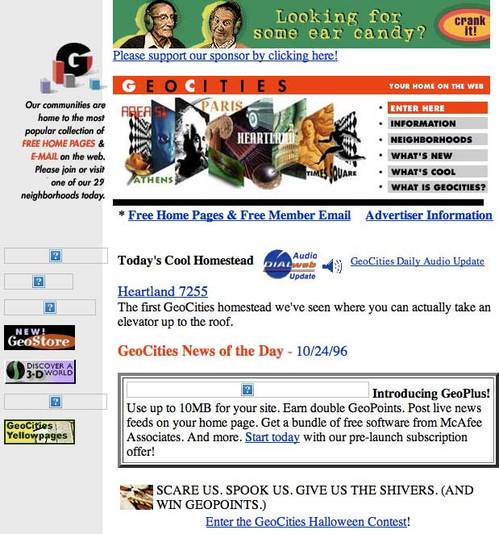7 Ways the Internet Sucked in the 1990s
 |
If you weren’t conscious of the Internet in the 1990s then you missed out on a lot frustration and hardship. Oh, everyone said it was great, that it was the future, that it would be the ultimate database of knowledge across the planet — but it was hard to be anything but skeptical when half the websites were made on Geocities.
7) Geocities
 |
And speaking of Geocities! Geocities was the web’s answer to public access television in the 1990’s – anyone and everyone could make a website with just enough web space to get people into trouble. There were a lot of terrible websites, most nightmarishly awful and bad and maybe one or two brilliant gems out of tens of thousands. The crux of it meant that if you were to go to a friend’s website at the time, it was likely on Geocities. You not only had to run up against the terrible — webpages were sorted into “neighborhoods” with URLs ending up something like http://www.geocities.com/neighborhood/suburb/1234 — every website was set up into a “neighborhood” and then a “suburb” and a four digit number. The neighborhoods were set up to be assigned to a specific genre, like “Area51” was all sci-fi pages (which was the largest by far) or “Paris” was the arts, or “Southbeach” was uh, just hanging out.
6) Searching for Anything
 |
Up until 1996, there weren’t any major search engines on the internet. Then after that, there were too many search engines. You had your choice of Yahoo, AltaVista, Hotbot, Lycos, Excite, Webcrawler, Infoseek, Alltheweb, and eventually Google. It went from “I can’t find anything” to “I still can’t find anything, and now I don’t know what the hell to use to not find it, and by the way I’m going to smash this computer with a hammer.”
5) Animated Gifs
 |
 |
 |
4) Scrolling, Blinking Text
Yes! I would like to read your crappy welcome message! Can I please? For some reason people this would be the reaction to people seeing text scrolling from right to left or left to right on a web page. You know, because if it was important, you wouldn’t want to put it on your page where someone could read it instantly, no, you would want to have people wait 15 seconds to see whatever nonsense you happened to come up with, like “Welcome to my awesome site!!” or “Dave is a weiner!”
This HTML tag was called the “Blink Element” If you don’t see the italicized text above blinking now that’s because you are using a modern browser that has done away with an idea about as bad as making washing Tide Pods look like candy. Like scrolling text, blinking text was created because it looked “cool;” unfortunately, nobody realized “cool” can often turn into “annoying” within mere minutes.
You do have to understand that this was a time when people had yet to figure out that you could simply change fonts, or just bold text to draw attention to it. They were simpler people. In simpler times.
3) Realplayer
 |
Realplayer, an internet standard from 1995 onward, used some ingenious methods for viewing videos on lo-definition and lo-speed systems…. and it was still the worst program the internet has ever seen. With limited color depth, framerate, and resolution, it’s like watching an IMAX movie converted to Mutoscope, that’s how archaic the technology was. Another thing to consider is that the Realplayer program itself tended rewrite your Windows Registry and make itself the default Media Player without asking. It was kind of like the brother-in-law who stops by for a week and doesn’t leave because he’s moved into the walls of your house.
2) Automatic MIDI Files
Many personal websites had music on them that played automatically using the best technology that was available for incredibly slow Internet connections, MIDI files. These files gave your sound card a series of instructions to produce music that sounded at worst, like a bad ’80s Keytar, and at best, a really good ’80s Keytar. So, just imagine going to a personal website and having to wait for the site to load the dulcimer tones of Metallica’s “Enter Sandman” or the Cranberries’ “Dreams” on an ’80s Keytar.
1) AOL
If you were on the internet in the 1990s, you were probably on AOL as at their height they had 27 million users. AOL sucked even more then than it did now. First of all, you were inundated in the real world with AOL disks – you couldn’t open up a mailbox without five of them falling out. Also, before they started charging a flat rate of $19.95 a month in 1996, they charged an hourly rate, which in 1993 started at $9.95 for five hours a month. Yes! Five hours of low speed service, with additional hours for $3.50 each. So, for the cost of what a person might pay now for a month of hi-speed access you could stay online for just under 24 hours straight. Also, you could browse the web on their, uh, web browser, but it was a pile of crap. They eventually bought Netscape to do nothing with it. It didn’t really matter to most people as they just logged in for private chat rooms. You know, just to talk to people privately. About wieners.

